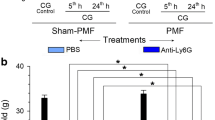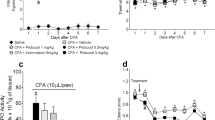Abstract
In this study, we evaluated the possible effects of sequenced pulsed magnetic fields (PMF) of 1-mT treatments with designed different frequencies (PMF-1—1, 3, 5, 7 Hz or PMF-2—7, 9, 12, 14 Hz) on the inflammatory signs such as abnormal pain behaviors, hyperalgesia and allodynia, edema, and fever in carrageenan (CG)-induced hind paw inflammation model in rats. Paw tissues were also histologically examined. PMF exposure was applied 3 times in 24 h. CG injection gradually decreased the thermal latencies and mechanical threshold and caused significant increases in temperature and mass of paw. PMF treatments significantly reduced the temperature and mass in the paw of rats with inflammation. PMF-1 treatments caused significant increases in the latencies and thresholds. However, administration of PMF-2 treatment was significantly decreased the latency and threshold. Furthermore, the histological pieces of evidence also suggested the anti-inflammatory effects of PMF-1 treatments or inflammatory actions of PMF-2 treatments. Findings presented in this paper suggest that 1-mT PMF treatments may have anti-edematous and antipyretics activities in inflamed rats. However, the effects of PMF treatments on abnormal pain hypersensitivities may be different. PMF treatments may make inflammatory pain relief or worse in inflamed rats depending on the PMF frequencies in sequence.







Similar content being viewed by others
References
Barrot M (2012) Tests and models of nociception and pain in rodents. Neuroscience 211:39–50
Basbaum AI, Bautista DM, Scherrer G, Julius D (2009) Cellular and molecular mechanisms of pain. Cell 139(2):267–284
Coutaux A, Adam F, Willer JC, Le Bars D (2005) Hyperalgesia and allodynia: peripheral mechanisms. Joint Bone Spine 72(5):359–371
Dortch AB, Johnson MT (2006) Characterization of pulsed magnetic field therapy in a rat model for rheumatoid arthritis. Biomed Sci Instrum 42:302–307
Foletti A, Grimaldi S, Lisi A, Ledda M, Liboff AR (2013) Bioelectromagnetic medicine: the role of resonance signaling. Electromagn Biol Med 32(4):484–499
Funk RH, Monsees TK (2006) Effects of electromagnetic fields on cells: physiological and therapeutical approaches and molecular mechanisms of interaction. A review. Cells Tissues Organs 182(2):59–78
Hug K, Roosli M (2012) Therapeutic effects of whole-body devices applying pulsed electromagnetic fields [PEMF]: a systematic literature review. Bioelectromagnetics 33(2):95–105
Kubat NJ, Moffett J, Fray LM (2015) Effect of pulsed electromagnetic field treatment on programmed resolution of inflammation pathway markers in human cells in culture. J inflamm Res 8:59–69
Leone S, Chiavaroli A, Orlando G, Mollica A, Di Nisio C, Brunetti L, Vacca M (2012) The analgesic activity of biphalin and its analog AM 94 in rats. Eur J Pharmacol 685(1-3):70–73
Libby P (2007) Inflammatory mechanisms: the molecular basis of inflammation and disease. Nutrition Rev 65:140–146
Markov MS (2007) Expanding use of pulsed electromagnetic field therapies. Electromagn Biol Med 26:257–274
Markov M, Nindl G, Hazelwood C, Cuppen J (2006) Interactions between electromagnetic fields and immune system: possible mechanism for pain control. In: Ayrapetyan SN, Markov MS (eds) Bioelectromagnetics Current Concepts. NATO Security Through Science Series. Springer, Dordrecht, pp 213–225
McKay JC, Prato FS, Thomas AW (2007) A literature review: the effects of magnetic field exposure on blood flow and blood vessels in the microvasculature. Bioelectromagnetics 28(2):81–98
Mert T (2017) Pulsed magnetic field treatment as antineuropathic pain therapy. Rev Neurosci 28(7):751–758
Mert T, Ocal I, Cinar E, Yalcin MS, Gunay I (2014) Pain-relieving effects of pulsed magnetic fields in a rat model of carrageenan-induced hindpaw inflammation. Int J Radiat Biol 90(1):95–103
Mert T, Gisi G, Celik A, Baran F, Uremis MM, Gunay I (2015) Frequency-dependent effects of sequenced pulsed magnetic field on experimental diabetic neuropathy. Int J Radiat Biol 91(10):833–842
Mert T, Kurt AH, Altun I, Celik A, Baran F, Gunay I (2017) Pulsed magnetic field enhances therapeutic efficiency of mesenchymal stem cells in chronic neuropathic pain model. Bioelectromagnetics 38(4):255–264
Morris CJ (2003) Carrageenan-induced paw edema in the rat and mouse. Methods Mol Biol 225:115–121
Pilla AA (2013) Nonthermal electromagnetic fields: from first messenger to therapeutic applications. Electromagn Biol Med 32(2):123–136
Prato FS (2015) Non-thermal extremely low frequency magnetic field effects on opioid related behaviors: snails to humans, mechanisms to therapy. Bioelectromagnetics 36:333–348
Ren K, Dubner R (2010) Interactions between the immune and nervous systems in pain. Nat Med 16(11):1267–1276
Robertson JA, Juen N, Theberge J, Weller J, Drost DJ, Prato FS, Thomas AW (2010) Evidence for a dose-dependent effect of pulsed magnetic fields on pain processing. Neurosci Lett 482:160–162
Sandkühler J (2009) Models and mechanisms of hyperalgesia and allodynia. Physiol Rev 89(2):707–758
Santini MT, Rainaldi G, Indovina PL (2009) Cellular effects of extremely low frequency (ELF) electromagnetic fields. Int J Radiat Biol 85(4):294–313
Selvam R, Ganesan K, Narayana Raju KV, Gangadharan AC, Manohar BM, Puvanakrishnan R (2007) Low frequency and low intensity pulsed electromagnetic field exerts its antiinflammatory effect through restoration of plasma membrane calcium ATPase activity. Life Sci 80(26):2403–2410
Shupak NM, Prato FS, Thomas AW (2004) Human exposure to a specific pulsed magnetic field: effects on thermal sensory and pain thresholds. Neurosci Lett 363:157–162
Simko M, Mattsson MO (2004) Extremely low frequency electromagnetic fields as effectors of cellular responses in vitro: possible immune cell activation. J Cell Biochem 93(1):83–92
Strauch B, Herman C, Dabb R, Ignarro LJ, Pilla AA (2009) Evidence based use of pulsed electromagnetic field therapy in clinical plastic surgery. Aesthet Surg J 29:135–143
Tenforde TS (1992) Biological interactions and potential health effects of extremely-low-frequency magnetic fields from power lines and other common sources. Annu Rev Public Health 13:173–196
Tenforde T, Kaune W (1987) Interaction of extremely low-frequency electric and magnetic fields with humans. Health Phys 53:585–566
Walleczek J, Budinger TF (1992) Pulsed magnetic field effects on calcium signaling in lymphocytes: dependence on cell status and field intensity. FEBS Letters 314:351–355
Zhang JM, An J (2007) Cytokines, inflammation, and pain. Int Anesthesiol Clin 45:27–37
Zhou S, Uesaka M (2006) Bioelectrodynamics in living organisms. Int J Eng Sci 44:67–92
Acknowledgments
We thank Dr. Tuba Ozcan Metin for the histological examinations and assistance.
Funding
This study was supported by the Scientific and Technological Research Council of Turkey, grant number 116S502.
Author information
Authors and Affiliations
Corresponding author
Ethics declarations
All experimental procedures were approved by the Kahramanmaras Sutcu Imam University institutional animal care and use committee (2016/03/03/04).
Conflict of interest
The authors declare that they have no conflict of interest.
Additional information
Responsible Editor: Mohamed M. Abdel-Daim
Publisher’s note
Springer Nature remains neutral with regard to jurisdictional claims in published maps and institutional affiliations.
Rights and permissions
About this article
Cite this article
Mert, T., Yaman, S. Pro-inflammatory or anti-inflammatory effects of pulsed magnetic field treatments in rats with experimental acute inflammation. Environ Sci Pollut Res 27, 31543–31554 (2020). https://doi.org/10.1007/s11356-020-09401-z
Received:
Accepted:
Published:
Issue Date:
DOI: https://doi.org/10.1007/s11356-020-09401-z




